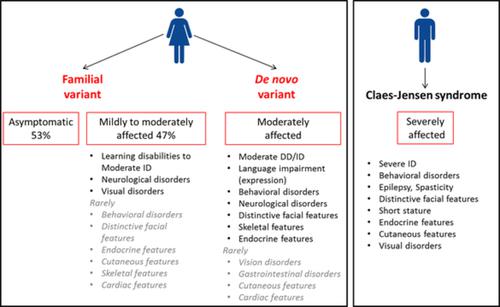当前位置:
X-MOL 学术
›
Clin. Genet.
›
论文详情
Our official English website, www.x-mol.net, welcomes your
feedback! (Note: you will need to create a separate account there.)
Further delineation of the female phenotype with KDM5C disease causing variants: 19 new individuals and review of the literature.
Clinical Genetics ( IF 2.9 ) Pub Date : 2020-04-11 , DOI: 10.1111/cge.13755 Virginie Carmignac 1, 2 , Sophie Nambot 1, 3, 4, 5 , Daphné Lehalle 3 , Patrick Callier 1, 4, 5 , Stephanie Moortgat 6 , Valérie Benoit 6 , Jamal Ghoumid 7, 8 , Bruno Delobel 9 , Thomas Smol 8, 10 , Caroline Thuillier 10 , Cécile Zordan 11 , Sophie Naudion 11 , Thierry Bienvenu 12, 13, 14 , Renaud Touraine 15 , Francis Ramond 15 , Christiane Zweier 16 , André Reis 16 , Cornelia Kraus 16 , Mathilde Nizon 17 , Benjamin Cogné 17 , Alain Verloes 18 , Frédéric Tran Mau-Them 1, 4 , Arthur Sorlin 1, 3, 4 , Thibaud Jouan 1 , Yannis Duffourd 1, 5 , Emilie Tisserant 1, 5 , Christophe Philippe 1, 4 , Antonio Vitobello 1, 4 , Julien Thevenon 1, 3, 5 , Laurence Faivre 1, 3, 4, 5 , Christel Thauvin-Robinet 1, 4, 5, 19
Clinical Genetics ( IF 2.9 ) Pub Date : 2020-04-11 , DOI: 10.1111/cge.13755 Virginie Carmignac 1, 2 , Sophie Nambot 1, 3, 4, 5 , Daphné Lehalle 3 , Patrick Callier 1, 4, 5 , Stephanie Moortgat 6 , Valérie Benoit 6 , Jamal Ghoumid 7, 8 , Bruno Delobel 9 , Thomas Smol 8, 10 , Caroline Thuillier 10 , Cécile Zordan 11 , Sophie Naudion 11 , Thierry Bienvenu 12, 13, 14 , Renaud Touraine 15 , Francis Ramond 15 , Christiane Zweier 16 , André Reis 16 , Cornelia Kraus 16 , Mathilde Nizon 17 , Benjamin Cogné 17 , Alain Verloes 18 , Frédéric Tran Mau-Them 1, 4 , Arthur Sorlin 1, 3, 4 , Thibaud Jouan 1 , Yannis Duffourd 1, 5 , Emilie Tisserant 1, 5 , Christophe Philippe 1, 4 , Antonio Vitobello 1, 4 , Julien Thevenon 1, 3, 5 , Laurence Faivre 1, 3, 4, 5 , Christel Thauvin-Robinet 1, 4, 5, 19
Affiliation

|
X‐linked intellectual disability (XLID) is a genetically heterogeneous condition involving more than 100 genes. To date, 35 pathogenic variants have been reported in the lysine specific demethylase 5C (KDM5C ) gene. KDM5C variants are one of the major causes of moderate to severe XLID. Affected males present with short stature, distinctive facial features, behavioral disorders, epilepsy, and spasticity. For most of these variants, related female carriers have been reported, but phenotypic descriptions were poor. Here, we present clinical and molecular features of 19 females carrying 10 novel heterozygous variants affecting KDM5C function, including five probands with de novo variants. Four heterozygous females were asymptomatic. All affected individuals presented with learning disabilities or ID (mostly moderate), and four also had a language impairment mainly affecting expression. Behavioral disturbances were frequent, and endocrine disorders were more frequent in females. In conclusion, our findings provide evidence of the role of KDM5C in ID in females highlighting the increasing implication of XLID genes in females, even in sporadic affected individuals. Disease expression of XLID in females should be taken into consideration for genetic counseling.
中文翻译:

用KDM5C疾病引起变体的女性表型的进一步描述:19个新个体,并复习文献。
X连锁智力障碍(XLID)是一种遗传异质性疾病,涉及100多个基因。迄今为止,已经报道了赖氨酸特异性脱甲基酶5C(KDM5C)基因中的35种致病变体。KDM5C变体是中度至严重XLID的主要原因之一。受影响的男性身材矮小,面部特征鲜明,行为异常,癫痫和痉挛。对于这些变体中的大多数,已经报道了相关的雌性携带者,但是表型描述很差。在这里,我们介绍19位携带10种影响KDM5C的新型杂合变异体的女性的临床和分子特征功能,包括五个带有de novo变体的先证者。四名杂合子女性无症状。所有受影响的人都有学习障碍或学习障碍(多数为中度),其中四人的语言障碍也主要影响表达。行为障碍频繁,女性内分泌失调更为频繁。总之,我们的发现提供了KDM5C在雌性ID中的作用的证据,突显了XLID基因在雌性中的影响越来越大,即使在零星感染的个体中也是如此。遗传咨询应考虑女性中XLID的疾病表达。
更新日期:2020-04-11
中文翻译:

用KDM5C疾病引起变体的女性表型的进一步描述:19个新个体,并复习文献。
X连锁智力障碍(XLID)是一种遗传异质性疾病,涉及100多个基因。迄今为止,已经报道了赖氨酸特异性脱甲基酶5C(KDM5C)基因中的35种致病变体。KDM5C变体是中度至严重XLID的主要原因之一。受影响的男性身材矮小,面部特征鲜明,行为异常,癫痫和痉挛。对于这些变体中的大多数,已经报道了相关的雌性携带者,但是表型描述很差。在这里,我们介绍19位携带10种影响KDM5C的新型杂合变异体的女性的临床和分子特征功能,包括五个带有de novo变体的先证者。四名杂合子女性无症状。所有受影响的人都有学习障碍或学习障碍(多数为中度),其中四人的语言障碍也主要影响表达。行为障碍频繁,女性内分泌失调更为频繁。总之,我们的发现提供了KDM5C在雌性ID中的作用的证据,突显了XLID基因在雌性中的影响越来越大,即使在零星感染的个体中也是如此。遗传咨询应考虑女性中XLID的疾病表达。











































 京公网安备 11010802027423号
京公网安备 11010802027423号